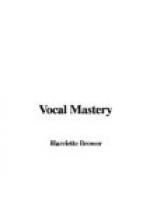Frieda Hempel: “The very first thing for a singer to consider is breath control—always the breathing, the breathing. She thinks of it morning, noon and night. Even before rising in the morning she has it on her mind, and may do a few little stunts while still reclining. Then, before beginning vocal technic in the morning, she goes through a series of breathing exercises.”
David Bispham: “Correct breath control must be carefully studied and is the result of understanding and experience. When the manner of taking breath and the way to develop the diaphragm and abdominal muscles, is understood, that is only a beginning. Management of the breath is an art in itself. The singer must know what to do with the breath once he has taken it in, or he may let it out in quarts when he opens his mouth. He learns how much he needs for each phrase; he learns how to conserve the breath.”
Oscar Saenger: “The management of the breath is a most important factor, as the life of the tone depends on a continuance of the breath. The student must cultivate the power of quickly inhaling a full breath, and exhaling it so gradually that she can sing a phrase lasting from ten to twenty seconds. This needs months of arduous practice. In all breathing, inhale through the nose.”
Yeatman Griffith: “Breath control is indeed a vital need, but should not be made a bugbear to be greatly feared. Most students make breathing and breath control a difficult matter, when it should be a natural and easy act. They do not need the large amount of breath they imagine they do, for a much smaller quantity will suffice. When you open the lips after a full, natural breath, do not let the breath escape; the vocal chords will make the tone, if you understand how to make a perfect start.”
SPECIFIC EXERCISES
Great singers are chary of giving out vocal exercises which they have discovered, evolved, or have used so constantly as to consider them a part of their own personal equipment, for reasons stated earlier in this chapter. However, a few artists have indicated certain forms which they use. Mme. d’Alvarez remarks: “When I begin to study in the morning, I give the voice what I call a massage. This consists of humming exercises, with closed lips. Humming is the sunshine of the voice. One exercise is a short figure of four consecutive notes of the diatonic scale, ascending and descending several times; on each repetition of the group of phrases, the new set begins on the next higher note of the scale. This exercise brings the tone fully forward.”
Lehmann counsels the young voice to begin in the middle and work both ways. Begin single tones piano, make a long crescendo and return to piano. Another exercise employs two connecting half tones, using one or two vowels. During practice stand before a mirror.




